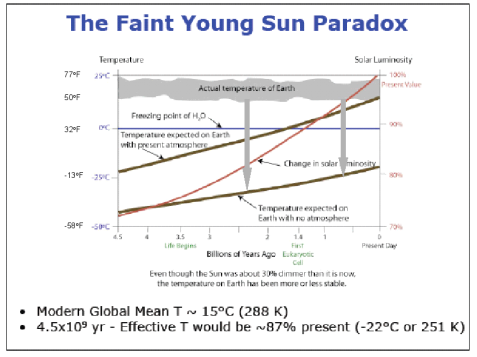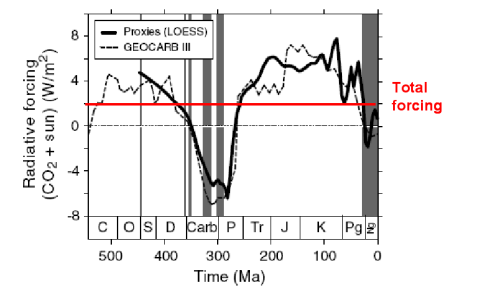Climate Factors
Here is a brief summary of those physical factors which influence a planet’s climate and in the case of Earth, make life possible. These are included in the anthropogenic global warming theory presented in the Intergovernmental Panel on Climate Change (IPCC) reports [IPCC, 2007].
- Solar luminosity
- Atmospheric greenhouse effect
- Carbon dioxide
- Methane
- Ozone
- Water vapor
- Nitrous Oxide
- Others…
- Earth orbital variation
- Croll-Milankovic cycles
- The fortuitous circumstance of our large moon which stabilizes Earth’s orbit.
- Earth’s oceans
- Plate tectonics
- Position of continents and oceans
- High mountains (long term weathering and winds)
- Ocean circulation
- Subduction and regeneration of CO2
- Volcanism
- contributes CO2 (carbon cycle)
- contributes aerosols and dust
- Plant and bacterial life via photosynthesis
- Consumption of CO2
- Creation of oxygen
- Amplification of rock weathering
- Burial of organic matter in oceans
- Mountain weathering and deposition as carbonate layers in oceans
- Surface and cloud Albedo
- Glaciers and polar ice sheets
- Geothermal heating from radioactive decay
- Land use
- Air currents
This is not necessarily a complete list. These factors are not in any special order and are interrelated. Plate tectonics would not be possible without Earth’s oceans for example.
Faint Young Sun Paradox
Having observed that the Earth climate system is complex, I want to focus on the two principle components, the solar luminosity and the atmosphere. Joseph Fourier published the first energy balance for the Earth back in 1826. He calculated that in order for incoming solar radiation and outgoing heat radiation to balance, the Earth would only be about -18oC assuming the Earth is a black body radiator and absorbs all of the incoming energy. In fact, even then some of the solar energy would be reflected back out into space without warming the Earth and it would be even colder as shown in Figure 1. Fourier hypothesized in his paper that the atmosphere must have some effect which is keeping the planet warm. In 1860 John Tyndall discovered that carbon dioxide, water vapor, methane and ozone were the greenhouse gases responsible for the warming the planet. This was surprising at the time because all of these gases have very low concentrations in the atmosphere the bulk of which is nitrogen and oxygen.

Figure 1 – Solar and atmospheric forcing overview
The red curve in Figure 1 illustrates the “faint young Sun” paradox, [from Koch, 2008]. Our sun is a G2 star on the main sequence; it was only 70% as luminous then as now. This is because the sun was mostly low density hydrogen. As fusion takes place in the solar core, four hydrogen protons combine to form one helium nucleus releasing energy by a complex process of collisions and reactions. As hydrogen is converted to helium, the core density increases as does the temperature and pressure resulting in a higher probability of fusion reactions and more radiation. Yet since about 4 billion years ago the Earth has always had a temperature compatible with liquid surface water and life. Earth’s surface temperature is thought to have varied between about 10 and 25 degrees C throughout its history, except for the Hadean Eon as shown by the grey band in Figure 1.
The lower of the two brown curves in Figure 1 is the Earth’s temperature without an atmosphere and the upper curve shows what the temperature would have been with today’s atmospheric concentrations. We first observe the profound impact of the greenhouse gases on the Earth temperature today, warming our planet from about -18oC to about +15oC.
What mechanism kept the Earth warm before present time? And how did this mechanism constrain the Earth’s temperature to such a narrow window despite the solar luminosity changes? Why didn’t the Earth freeze and what would have happened if it did?
Possible excursions below this range are thought to have occurred in the Proterozoic about 2.25 billion years ago and again between 750 and 590 million years ago. These snowball Earth events are shown by the two grey arrows in this figure. Earth’s temperature plummeted and the oceans froze to the equator. These events are contemporaneous with the two step-wise increases in atmospheric oxygen, the first from practically no oxygen to about 2% of the atmosphere by volume and the second to the present level of about 20% of the atmosphere by volume.
Figure 2 shows the atmospheric carbon dioxide partial pressure needed to maintain a temperate climate throughout Earth’s history. Since atmospheric oxygen was low during the Archean Eon, before 2.35 billion years ago, both methane and carbon dioxide could have been dominant greenhouse gases. A possible moderating feedback mechanism, involving both these gases is described by [Kastings, 2000]. However, during the Proterozoic and Phanerozoic Eons, carbon dioxide alone would have had to keep the Earth warm and balance the increasing solar radiation. This feedback process is described by [Berner, 2004]. It is called the carbonate-silicate cycle or the long term carbon cycle. Briefly, when the Earth warms, water evaporates off the oceans increasing rainfall. The water vapor combines with carbon dioxide in the atmosphere creating carbonic acid. These acids rain onto silicate rocks increasing the rate of weathering and carbonate sediment formation, effectively leaching the carbon dioxide out of the atmosphere. As a result the Earth cools. A cooler Earth results in less evaporation and less rainfall and subsequently less weathering and burial. This negative feedback cycle operates over millions of years.

Figure 2 – Solar luminosity and CO2 partial pressure
Berner makes the point that the principle greenhouse gas is. We read that methane as a greenhouse gas is stronger than by a factor of between 21 and 33 depending on how it is measured but in all cases this only applies for up to one hundred years, a period which is entirely relevant to the current human condition but not important over geologic time. Methane reacts with atmospheric oxygen to become and water fairly quickly. The residence time of is only about ten years. During the Archean Eon when there was little to no atmospheric oxygen, methane may have been the dominant greenhouse gas. Although vapor is the strongest greenhouse gas, “it is buffered by evaporation and condensation that is driven by external factors such as solar radiation and the greenhouse effect.” [Berner, 2004]
Figure 3 [Royer, 2006] shows the combined solar forcing and the carbon dioxide forcing. Hot house climates experienced only 4 to 6 W/m2 radiative forcing above pre-industrial values. In other words, despite solar radiation which was increasing by about 5% over the phanerozoic, or about 12 W/m2, reduced levels of atmospheric carbon dioxide maintained the Earth’s temperate climate. This figure also illustrates the correlation between global temperature and ice ages over the entire Phanerozoic. Note that all ice ages occur when the combined solar- forcing is relatively the same as pre-industrial Holocene demonstrating a high correlation between atmospheric and global temperature including the Ordovician-Silurian boundary glaciation as described by [Young, 2009].

Figure 3 Combined radiative forcing relative to pre-industrial 280 ppmV carbon dioxide [from Royer, 2006]
According to [NASA, 2009] and [Trenberth, 2009] the total increase in radiative forcing including all factors since 1850 is about 1.8 W/m2. This increase is shown by the red line in Figure 3. We can see that the Earth’s climate is potentially being forced into a hothouse regime from the current ice house climate in a geologically short time. Often, such excursions are associated with extinction events especially when combined with other factors such as in the present case over fishing, deforestation and mountaintop removal mining [Hallam, 2004].
— Tony Noerpel
————————————————————————————-
References:
[Hoffman] http://www.snowballearth.org/week8.html
[Young, 2009] Young, Saltzman, Foland, Linder and Kump, “A major drop in seawater 87Sr/86Sr during the Middle Ordovician (Darriwilian): Links to volcanism and climate?” Geology, October, 2009.
[Hallam, 2004] Hallam, Catastrophes and Lesser Calamities, Oxford University Press.
[Royer, 2006] Royer, “CO2-forced climate thresholds during the Phanerozoic”, Geochimica et Cosmochimica Acta 70 (2006) 5665–5675
[Berner, 2004], Robert, The Phanerozoic Carbon Cycle, Oxford University Press, 2004.
[Trenberth, 2009] Trenberth, K. E., 2009: An imperative for adapting to climate change: Tracking Earth’s global energy. Current Opinion in Environmental Sustainability, 1, 19-27. DOI 10.1016/j.cosust.2009.06.001.
[NASA, 2009] http://data.giss.nasa.gov/modelforce/
[Koch, 2008] http://es.ucsc.edu/~pkoch/pages/classes.htm
[Kasting, 2000] Kasting, Pavlov, Brown, Rages, Freedman, “Greenhouse warming in the atmosphere of early Earth,” Journal of Geophysical research, v 105, no. E5, 11,981-11990, May 25, 2000.




You must be logged in to post a comment.